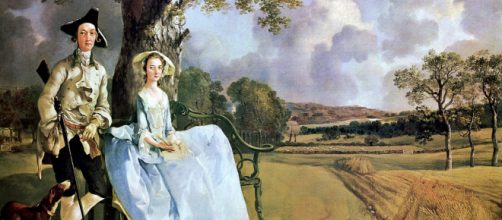New research suggests that England's celebrated 18th-century portrait painter Thomas Gainsborough, the son of a bankrupt wool merchant, wouldn't have attained his fame if it weren't for the murder of his uncle who left him money to study with drawing master Hubert Francois Gravelot.
On second thought
Mark Bill, director of the Gainsborough House who uncovered the story of the murder and inheritance, told the Guardian that the impact of the artist's family bankruptcy drove him to choose painting portraits rather than his first choice - landscapes - to ensure a good income.
As Bill put it, '”I think people who have been really poor never lose that concern about money.” But Gainsborough's correspondence, annotated by historians Robert Goldwater and Marco Treves in 1956 and omitted from the new research tells a different story; he was not only unimpressed by money, but he also didn't put up with criticism from the rich who hired him, either.
All that glitters is not gold
In a letter dated March 13, 1758, to “Mr. Edgar of Colchester,” an attorney for a family that commissioned portraits, Gainsborough ridiculed their complaint that his work showed “roughness of a surface.” He began by pointing out that the texture gives force to the painting at a distance. He then proceeded to mock “eyes half an inch” from his painting: “I don't think it would be more ridiculous for a person to put his nose close to the canvas and say the colors smell offensive than to say how rough the paint lies.” One may wonder how Gainsborough House director Bill miss this letter?
Another reason
And in a letter to his friend William Jackson on June 4, 1768, Gainsborough spoke of his preference for landscape painting and explained that it was his daughters' needs that motivated him to be a portraitist. “These fine ladies (his daughters) and their tea-drinkings, husband-hunting, etc., etc., etc., will job me out of the last ten years...But we can say nothing to these things you know Jackson, we must jog on and be content.” Clearly, his family's bankruptcy had nothing to do with his choice of subject matter.
And even though he felt stuck capturing the likenesses of the gentry, he stayed away from doing it indoors as much as possible. A typical example is “Mrs. Andrews,” which portrays a country squire and his wife in the Great Outdoors.
Pooh-poohing pomp
One more thing countering the contention from the Gainsborough House director's research that the painter catered to the rich because he never got over being poor.
He didn't do much catering when it came to those who sat for portraits seeking to puff themselves up. Historian Edward Lucie-Smith noted in a 1992 anthology of artists' anecdotes that when a certain lord came to be painted all dolled up in a powdered wig and wearing a self-important expression on his face, Gainsborough laughed and refused to paint him. He did this with other lords too, saying, “They have everybody's faces but their own.”


